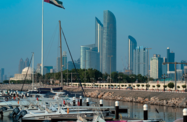Buoyed by positive growth in 2011, Abu Dhabi looks set to see a strong economic performance again this year. Though efforts to diversify the economy continue, high oil prices ensured that energy was the emirate’s strongest performer last year, even as non-oil sectors’ contribution to GDP increased.
Figures released by the Statistics Centre - Abu Dhabi (SCAD) in early July show that the emirate’s GDP grew by a nominal 29.9% in 2011, exceeding $200bn for the first time and putting its economy near the top of the list for global growth.
Commenting on the figures, SCAD said the significant growth across Abu Dhabi’s economy in both oil and non-oil sectors was a clear indication that the emirate had moved forward from economic turbulence. “These results demonstrate that the emirate’s economy has bounced to levels above those that dominated prior to the global financial crisis, giving it a huge competitive advantage and boosting its appeal to local and foreign investors,” it said.
The figures surprised both analysts and officials who had made lower estimates for Abu Dhabi’s 2011 GDP of approximately $155bn. High oil prices ensured that energy was the strongest performer in Abu Dhabi’s economy, accounting for 58.5% of income, with revenue from mining and quarrying activities, which mainly consists of oil extraction, rising by 53.2% last year.
Growth for the non-oil sector, by comparison, was 7%. Non-oil activities contributed 41.5% of the emirate’s GDP in 2011, rising from Dh99.3bn ($27bn) in 2001 to Dh334.3bn ($91bn) last year, according to SCAD. Broken down by sector, the transport, storage and communications sector increased by 22.4% in 2011; manufacturing by 21.5%; finance and insurance by 13.6%; real estate and business services by 11% each; and health and social services by 9.6%.
Although Abu Dhabi’s rate of growth is strong, SCAD emphasised that the data are preliminary, with a more accurate estimate to come after the formal confirmation of the figures from the fourth quarter of 2011. Inflation, however, is not expected to significantly affect GDP, with figures issued by SCAD showing that price increases for 2012 are likely to be similar to those of last year when the consumer price index (CPI) rose by just 1.9%.
Jarmo Kotilaine, the chief economist of National Commercial Bank in Saudi Arabia, expects Abu Dhabi’s growth rate for 2011 to be similar to that of the KSA once the numbers are finalised.
Saudi Arabia posted nominal growth of 28.2% last year, with real GDP growth later confirmed at just below 7%. In an interview with UAE daily The National on July 8, Kotilaine said the anticipated figures for Abu Dhabi “...certainly would point to a rebound in economic activity from the post-crisis situation, and that certainly goes beyond the oil sector”.
While the figures from SCAD signal good news on overall economic performance for Abu Dhabi, they also serve as a reminder that the emirate is still some way off reducing its reliance on hydrocarbons.
In its long-term plan, the emirate set out a target to lower the contribution oil makes to GDP from 58% to 36% by 2030. However, higher oil prices and the windfall revenue they generated in 2011 meant the sector’s contribution to Abu Dhabi’s economy actually rose by almost 10% last year from 49.7% in 2010.
Abu Dhabi may not reap such a high level of windfall profits from hydrocarbons this year if, as anticipated, global economic uncertainty continues to produce a drop in demand and lower prices for oil. However, analysts point to heightened activity in trade, transport, tourism and services, which are expected to play an increased role in helping maintain growth.
The emirate’s real estate sector, which suffered an oversupply of housing stock when it was hit by the world’s financial woes, is also showing signs of beginning to emerge from a slump. However, it will likely take time for confidence to return to the sector.
In the meantime, Abu Dhabi is set on a path to growth once again this year, with the non-oil sector’s contribution to GDP climbing steadily and the energy sector maintaining positive momentum.

